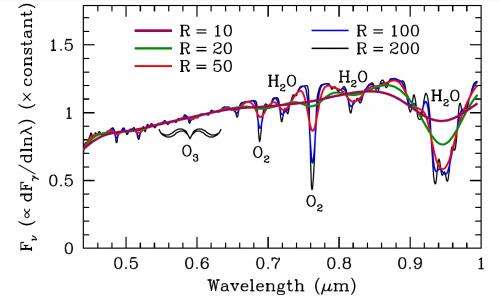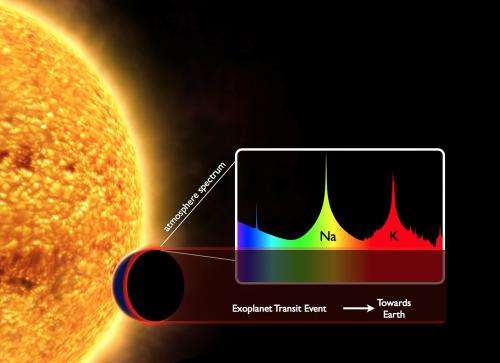What does the next generation telescope need to detect life?

Almost 2,000 extrasolar planets have been discovered to date and this number is constantly increasing. Yet, we still know little about these alien worlds, especially their atmospheres. The atmospheres of terrestrial exoplanets could betray the presence of life on the planet, sparking NASA's interest in acquiring the spectra that appears as starlight shines through these planetary atmospheres.
A paper by Timothy Brandt and David Spiegel, exo-planetary scientists at the Institute for Advanced Study, Princeton, details what is needed in a next generation telescope for it to be capable of detecting signatures of life in the atmospheres of alien planets. The paper has been published in the September issue of the journal Proceedings of the National Academy of Sciences.
Signatures of a habitable planet
Astronomers employ several different methods to study the atmospheres of gas giants that orbit close to their host stars. One such method involves comparing the spectrum of a star when a planet is transiting across the surface to a spectrum when the planet is out of transit. By comparing the spectra, it is possible to see which elements exist in the planet's atmosphere.
Methods like this still can't be used for terrestrial planets, as the height of the atmosphere engulfing a rocky planet is miniscule compared to that of a gas giant. Earth-like planets also orbit their stars at a larger distance, making it even more difficult to observe their atmospheres.
Observations of terrestrial planet atmospheres will require a specialized space mission that will use a coronograph to block out the blinding light of the star. While the James Webb Space Telescope, due to launch in 2018, will be capable of detecting elements in planetary atmospheres, it will still be limited to more massive planets.
"Our paper is an attempt to better define the requirements for a mission capable of detecting oxygen and water," says Brandt. "This is NASA's target, assuming technology developments in coronagraphy and adaptive optics permit it."
The detection of oxygen and water on another planet does not necessarily mean that life is present, but it certainly increases the chances that life might exist there. Oxygen on Earth is mainly produced by photosynthesis. However, the level of oxygen has varied dramatically over the lifetime of the Earth.
Also, it should be cautioned that oxygen can be produced abiotically. Water molecules can be broken apart in a process known as photolysis, and this can create abundant oxygen in a planetary atmosphere even when no life is present.
The paper by Brandt and Spiegel discusses the detection limits of chlorophyll. The chlorophyll in plants on Earth reflect more light in the infrared than they do in visible light, which causes a bump in the spectrum. This is known as the "red edge of chlorophyll," and it can be seen in the Earth's spectrum.

While the detection of chlorophyll would be exciting, there would also be some controversy surrounding such a detection. Using the "red edge" as a biosignature assumes that photosynthesis by plants on an alien world occurs in the exact same way as it does on Earth. In reality, such plants may use a molecule other than chlorophyll, or they may be optimized for light at a different wavelength.
"The main reason why a claimed detection would be so controversial is because it's easy to imagine features of your instrument or detector that could change the shape of the spectrum," adds Brandt. "The calibration of the instrument would have to be very, very good to trust a chlorophyll detection."
Signal-to-noise and resolution
The researchers used model spectra to calculate the signal-to-noise ratio that would be needed in order to detect biomarkers on terrestrial planets. The signal-to-noise ratio is a number that specifies how much actual data exist compared to "noise." Noise in this sense is not related to sound, rather it describes the "junk" signal that appears in the spectrum.
Noise can be caused by instrumental defects, or because the object under study is quite faint. Noise is inevitable in measurements of light; for example, a photograph taken in low light with a digital camera will appear grainy. A high signal-to-noise ratio indicates that the data is of high quality, and better results can be obtained. For example a signal-to-noise ratio of 10 means that the signal is 10 times stronger than the noise.
They also calculated the optimum spectral resolution needed to find the elusive signatures of life. Not to be confused with the angular resolution of a telescope, the resolution of a spectrograph is a number that details the ability of the spectrograph to differentiate between similar colors, or wavelengths, of light. For instance, if the resolution of the spectrograph is 100, it means that smallest difference in wavelength that can be resolved is one part in 100, or 1 percent. As with signal-to-noise, a higher number for spectral resolution is usually better, although this depends on the type of observations that are being performed.
Detecting biosignatures
Their results show that water is the easiest feature to detect in a terrestrial planet spectrum. It has several deep features that can still be seen even down to a low spectral resolution of 20, although the ideal minimum is 40 and a resolution of 200 would ensure much more detail of the water features. Assuming a resolution of 150, the signal-to-noise ratio only needs to be 3 in order to detect water.
Oxygen (O2) needs a resolution of at least 150 and a signal-to-noise ratio twice what is needed to detect water. As the ultraviolet light from stars creates ozone (O3), a logical step would also to be search for ozone, however this is not as easy as it sounds.
"The problem is that O3 is a broad, shallow feature, and is therefore very difficult to see," explains Brandt. "As a result, you might as well just look for the deeper, narrower O2 features."
For the red edge of chlorophyll, a low resolution of 20 will suffice, however the signal-to-noise needs to be six times higher than that needed to detect oxygen. This means a telescope would need to be trained on the planet for a very long time in order to gather enough light to have a high signal. The "red edge" would be easier to detect if the vegetation covered around 30 percent of the planet, or if the cloud cover was very low.
These results show that any future mission should be designed primarily with the detection of water and oxygen in mind. Given the difficulty in detecting chlorophyll, and the controversy surrounding such a detection, the authors suggest that chlorophyll should only be sought on the best targets.
One such future mission currently on the drawing board is the Advanced Technology Large-Aperture Space Telescope (ATLAST).
"It's hard to say whether ATLAST would be able to detect O2 and H2O in general," says Brandt. "It depends on many things, including the design of ATLAST (which is still very much a concept) and the distance of the planet from Earth."
If the ATLAST mission is given the go ahead, it would take images and spectra in the optical, infrared, and ultraviolet. Its primary mission would be to determine biosignatures, and it is planned for the 2025 to 2035 period.
Journal information: Proceedings of the National Academy of Sciences
Source: Astrobio.net
This story is republished courtesy of NASA's Astrobiology Magazine. Explore the Earth and beyond at www.astrobio.net .

















